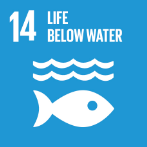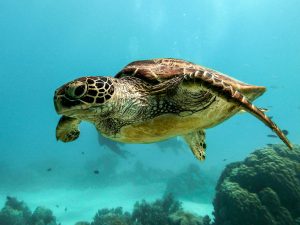SDG14 – Life Below Water

New Vocabulary
- storm
- absorb
- acidic
- disrupt
- coral reef
- marine
- conservation
- cooperation
- seafood
Practice the new vocabulary
Life Below Water Vocabulary Practice (text version)
Match the words to their definitions
Words:
- acidic
- coral reef
- storm
- cooperation
- disrupt
- seafood
- conservation
- absorb
- marine
Definitions:
- terrible weather that comes with lots of wind and rain or snow that can cause damage
- to take in
- having a chemical that can burn holes
- to prevent or stop an action from happening
- a line of hard rocks that can be found in warm shallow ocean water
- relating to the sea
- the protection of the environment, land and animals
- the act of working together well with another person or groups of people
- creatures from the sea that are edible
Check your answer in footnote[1]
Activity source: Life Below Water Vocabulary by Virginia McHardy, CC BY-NC 4.0
Life Below Water
According to the United Nations Department of Economic and Social Affairs (n.d.) Goal 14 Infographic:Goal 14 is about taking care of the ocean and using its resources in a sustainable way. The ocean covers most of the Earth, provides food, medicine, and energy, and helps clean pollution. It also protects us from storms and absorbs carbon dioxide, helping to slow climate change.
However, pollution is a serious problem. In 2021, 17 million metric tons of trash, mostly plastic, were in the ocean. This number could double or triple by 2040. The ocean is also becoming more acidic, harming sea life and food supplies. Climate change is making ocean temperatures rise, killing coral reefs and disrupting ecosystems.
Tourism and fishing industries depend on the ocean, but careless activities can damage marine life. About 57 million people work in fishing, and many depend on seafood for food.
To protect the ocean, we need international cooperation, better conservation efforts, and reduced plastic use. We should also choose sustainable seafood and only take what we need from the ocean.
Canadian Perspective
Goal 14, Life Below Water (text version)
Conserve and sustainably use the oceans, seas and marine resources for sustainable development
Conserved Ocean and Coastal Ecosystems
In 2022, 14.7% of Canada’s ocean and coastal ecosystems were conserved. [2] An area almost 16 times larger than in 2015. More than 60% of this area was located in the Arctic Ocean.
Canada’s Oceans in 2021[3]
In shallow waters, 29% of cold-water coral and sponge ecosystems; 34% of seagrass meadows; and 35% of kelp forests were conserved. Approximately 3% of the deepest waters were conserved.
Harvest Levels of Fish Stocks
More than 95% of fish stocks were sustainably harvested[4] at or below their removal reference or other approved level in 2021, down from 98% in 2020.
Community Spotlight: Clean Foundation
Clean Foundation helps communities make real progress toward a cleaner future by taking on climate change challenges. They work with communities to help foster coastal resiliency in Atlantic Canada by researching and restoring ecosystems.
Since 2013, Clean Foundation has deployed more than 600 reefballs in the Halifax Harbour. Reefballs are artificial reefs designed to: Provide shelter for fish and shellfish; serve as habitat for reproduction and spawning; and support the growth of marine plants.
Sources: Environment and Climate Change Canada, Canadian Environmental Sustainability Indicators, Canada’s Conserved Areas. Statistics Canada, Canadian System of Environmental-Economic Accounting – Ecosystem Accounts, 2022. Environment and Climate Change Canada, Canadian Environmental Sustainability Indicators, Harvest Levels of Key Fish Stocks. Clean Foundation, 2023.
Source: Goal 9, Industry, Innovation and Infrastructure In Agenda 2030 Sustainable Development Goals Report, 2022 by Statistics Canada, used under Open License
Discussion Questions
Use the new vocabulary words in these discussion questions. Ask and answer in partners or small groups:
- How do storms affect the ocean and marine life? Have you ever experienced a big storm near the sea?
- The ocean absorbs a lot of carbon dioxide and heat. Why is this important? What happens if the ocean absorbs too much?
- When the ocean becomes more acidic, it can harm marine life. How do you think this affects the food chain and seafood?
- How can pollution and climate change disrupt ocean ecosystems? What are some ways we can help protect marine life?
- Coral reefs are home to many sea creatures. Why do you think Coral reefs are important? What can happen if they disappear?
- What are some examples of marine animals? How do humans affect marine ecosystems?
- What does ocean conservation mean? What are some ways people can help protect the ocean?
- Why is international cooperation important for protecting the ocean? Can you think of a time when countries worked together to solve an environmental problem?
- Many people around the world eat seafood. How can we make sure seafood is caught in a way that does not harm the ocean? What are some seafood dishes from your culture?
Watch the video:
Watch Goal 14 – Life below water (2 mins) on YouTube
Video source: UNStats. (2022, July 7). Goal 14 – Life below water [Video]. YouTube. https://www.youtube.com/watch?v=bseQm52H7gU
Life Below Water Video Quiz (text version)
- Some causes that are endangering our global waters are:
- whales and sharks
- plastic pollution and ocean warming
- air pollution and sun damage
- True or false? The ocean absorbs about a quarter of the yearly CO2 emissions worldwide.
- True or false? It’s difficult to moderate climate change because the amount of acid in oceans is decreasing.
- Use the numbers provided to complete the sentence:
Numbers: 2040, 17, 3, 2021
Sentence: Plastic garbage in global waters measured over [Blank A] million tons in [Blank B], and by [Blank C] it will probably increase [Blank D] times that. - True or false? Most global fishers have jobs in small-scale fisheries.
Check your answer in footnote[5]
Activity source: Life Below Water Video Quiz by Virginia McHardy, CC BY-NC 4.0
Key Targets for SDG 14
- 14.1 By 2025, prevent and significantly reduce marine pollution of all kinds, in particular from land-based activities, including marine debris and nutrient pollution.
-
14.2 By 2020, sustainably manage and protect marine and coastal ecosystems to avoid significant adverse impacts, including by strengthening their resilience, and take action for their restoration in order to achieve healthy and productive oceans.
-
14.3 Minimize and address the impacts of ocean acidification, including through enhanced scientific cooperation at all levels.
-
14.4 By 2020, effectively regulate harvesting and end overfishing, illegal, unreported and unregulated fishing and destructive fishing practices and implement science-based management plans, in order to restore fish stocks in the shortest time feasible, at least to levels that can produce maximum sustainable yield as determined by their biological characteristics.
-
14.5 By 2020, conserve at least 10 per cent of coastal and marine areas, consistent with national and international law and based on the best available scientific information.
-
14.6 By 2020, prohibit certain forms of fisheries subsidies which contribute to overcapacity and overfishing, eliminate subsidies that contribute to illegal, unreported and unregulated fishing and refrain from introducing new such subsidies, recognizing that appropriate and effective special and differential treatment for developing and least developed countries should be an integral part of the World Trade Organization fisheries subsidies negotiation.
-
14.7 By 2030, increase the economic benefits to Small Island developing States and least developed countries from the sustainable use of marine resources, including through sustainable management of fisheries, aquaculture and tourism.
-
14.a Increase scientific knowledge, develop research capacity and transfer marine technology, taking into account the Intergovernmental Oceanographic Commission Criteria and Guidelines on the Transfer of Marine Technology, in order to improve ocean health and to enhance the contribution of marine biodiversity to the development of developing countries, in particular small island developing States and least developed countries.
-
14.b Provide access for small-scale artisanal fishers to marine resources and markets.
-
14.c Enhance the conservation and sustainable use of oceans and their resources by implementing international law as reflected in United Nations Convention on the Law of the Sea, which provides the legal framework for the conservation and sustainable use of oceans and their resources, as recalled in paragraph 158 of “The future we want”.
-
Source: United Nations Department of Economic and Social Affairs. (n.d.). Goal 14 [Infographic]. Sustainable Development Goals. https://sdgs.un.org/goals/goal14

Homework/Assignment:
- Design a poster with pictures and short messages about protecting the ocean.
- Imagine you are a sea animal (fish, dolphin, turtle). How would pollution or climate change affect your life? Write a short paragraph from the animal’s perspective.
You can read more about Goal #14 in The Sustainable Development Goals Report 2022 from the UN.:
For instructors, please visit York University’s The SDGs-in-the-Classroom Toolkit for lesson ideas
Attribution & References
Except where otherwise noted, this page is created by Virginia McHardy, CC BY-NC 4.0
References
United Nations Department of Economic and Social Affairs. (n.d.). Goal 14 [Infographic]. Sustainable Development Goals. https://sdgs.un.org/goals/goal14
- 1. storm, 2. absorb, 3. acidic, 4. disrupt, 5. coral reef, 6. marine, 7. conservation, 8. cooperation 9. seafood ↵
- Conserved areas are lands and waters where human use is limited. They include protected areas as well as other effective area-based conservation measures. ↵
- Percentages are for ecosystem areas which could be spatially mapped. Shallow waters are depths of less than 200 meters and deepest waters are defined as depths of more than 4000 meters. ↵
- The removal reference and other approved levels are based on scientific information. The indicator provides a direct measure of whether we are managing the use of these resources within these levels and it is one measure of fishing pressure on wild fish stocks. ↵
- 1. b, 2. True, 3. False, 4. a) 17, b) 2021, c) 2040, d) 3. 5. True. ↵
terrible weather that comes with lots of wind and rain or snow that can cause damage
to take in
having a chemical that can burn holes
a line of hard rocks that can be found in warm shallow ocean water
to prevent or stop an action from happening
relating to the sea
the act of working together well with another person or groups of people
the protection of the environment, land and animals
creatures from the sea that are edible

